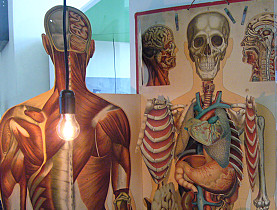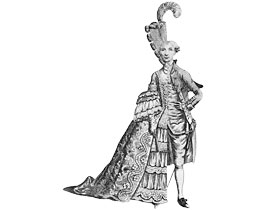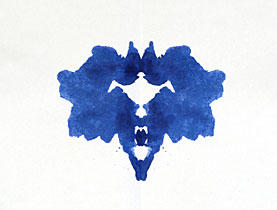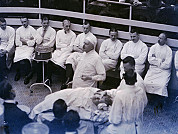Racing pulses and fluttering hearts

Stress, complicated love affairs, and supercilious superiors – this may sound like plotlines for a hit medical television series like Grey's Anatomy or House.
But as an exhibition into 175 years of medicine at Zurich University shows, it was also part of the daily lives of the very first men – and later women – in white coats.
Few figures excite the public imagination as much as the doctor, who spends years studying to gain enough medical knowledge to cure illnesses and – sometimes – even cheat death itself.
This noble image is probably a very old one, but has gained ground with the advent of modern universities and is very much in evidence at the current “Rookies to White Coats” exhibition, based on the medical history archives at Zurich University.
The university’s medical faculty has produced a few famous names in its time, including psychiatrist Hermann Rorschach, the father of the controversial inkblot test, but the exhibition is not solely devoted to these people.
“The history of medicine is much more than a celebration of the big names,” said Iris Ritzman, one of the curators.
“We wanted to show the students’ daily lives and what it was like to study then,” she added.
Love letters, newspaper clippings, and student magazines are featured alongside 19th century exercise books, showing that even then life was not too different to television.
“In fact, what you see on television is a rather old-fashioned view, the doctor who is superior to everyone around him, strong, made more humane by his own problems, but who never quite becomes one of the crowd,” explained Ritzman.
“In the past this aspect was fostered because studying medicine meant being part of the elite.”
Women’s influence
Nowadays medicine students attach less importance to prestige, which Ritzman attributes in part to the fact that more women have joined the profession. Women made up 52.3 per cent of medical students at the university in 2002.
But although Zurich University was the first in western Europe to accept female medical students in 1868, women did not have an easy time at first.
The university’s liberal approach led to a wave of Russian women studying there, who were allowed to be doctors but not study medicine in their homeland.
Unlike many other European universities, the professors generally accepted the female students – but their male peers did not, as can be seen through the crude caricatures in some of the student magazines.
“These were women who had lived in a Russia that was totally different to Switzerland,” said Ritzman. “They had the revolution in their blood, they smoked and wore their hair short… these two worlds collided and resulted in mutual incomprehension.”
Nevertheless a few romances came about, but often the differences were just too huge to guarantee long and happy marriages. Rorschach and Olga Stempelin, who married in 1909, were one of the rare exceptions.
The union of Friedrich Erismann and the first Russian female student in Zurich Nadezhda Suslova was not so lucky. But it did – indirectly – help produce the first Swiss woman doctor, Marie Vögtlin, in 1874.
Vögtlin was engaged to Erismann and was contemplating a life as wife and mother until he left her for Suslova. This was such as shock to Vögtlin that she started to question her aspirations as a woman and decided to study medicine.
Photos and models
The exhibition also sheds light on the evolution of didactic materials – from the first anatomic models in cardboard and the early teaching films of the 1930s, right up to modern day e-learning.
One of the most impressive displays is the more than 2,000-strong collection of photos belonging to the children’s hospital.
Dating from the late 19th century and used until the mid 20th century, these images were meant to help students learn which physical characteristics indicated a “degenerate personality type” or disease.
This could be indicated, according to the lore of the times, by such things as a tuft of hair, or the shape of the ear. A large smile could point to the bearer being a probable future criminal.
Nowadays this approach has been totally discredited. “This example of eugenics shows clearly that these medical ideas transmitted did not respect the laws of nature, but only the interpretations of the era,” said Ritzman.
But anatomic models have roughly stayed the same. “From a scientific point of view you could probably still use them,” said the curator. “But they stay linked to the times in which they were created through the hairstyles or materials used.”
One constant is that they are usually young, healthy and male. But in dissection, medical students normally only come across less than perfect corpses.
“Perhaps in 100 years’ time the models will become more realistic,” said Ritzman.
swissinfo, based on an Italian article by Doris Lucini in Zurich
The exhibition, which is free, runs until the end of May at the Foyer West in the main university building (closed Saturday afternoons, Sunday and holidays).
It displays 175 objects from the medical archives, some of which have never been shown in public before. It documents the history of medicine at Zurich University from its beginnings in 1833 to the 1970s.
A book (in German) also has been published to coincide with the exhibition.
Zurich University is currently celebrating its 175th anniversary with a series of exhibitions, conferences and displays open to the public. They all come under the motto of “sharing knowledge”.
Founded in 1833, the Universitas Turicensis was the first university in Europe with a democratic status rather than being under the patronage of a ruler or the church. 161 students signed up in the first year. There were four faculties – theology, law, medicine and philosophy – and 55 teaching staff.
Today there are around 24,000 students matriculated at Switzerland’s largest university in seven faculties – theology, law, medicine, economy, veterinary medicine, science and the arts.

In compliance with the JTI standards
More: SWI swissinfo.ch certified by the Journalism Trust Initiative



You can find an overview of ongoing debates with our journalists here. Please join us!
If you want to start a conversation about a topic raised in this article or want to report factual errors, email us at english@swissinfo.ch.